Elitch Gardens: How not to run a theme park
The first and largest park in the Denver area is Elitch Gardens, which advertises itself as "America's Only Downtown Theme & Water Park." This is actually the second incarnation of Elitch Gardens. The original "Elitch's", as it is known by locals, opened northwest of downtown Denver in 1890 as Elitch's Zoological Gardens. It featured floral gardens, the Elitch Theatre and the first zoo west of Chicago. The Theatre had a major impact on the performing arts in the western United States with the establishment of one of the first summer stock theatre companies in the country, which performed ten different plays over a 10-week season. Dozens of major stars performed on the Elitch Theatre stage from 1897 to 1987, from Grace Kelly (who was discovered there and went on to become Princess Grace of Monaco) to Robert Redford and even William Shatner.
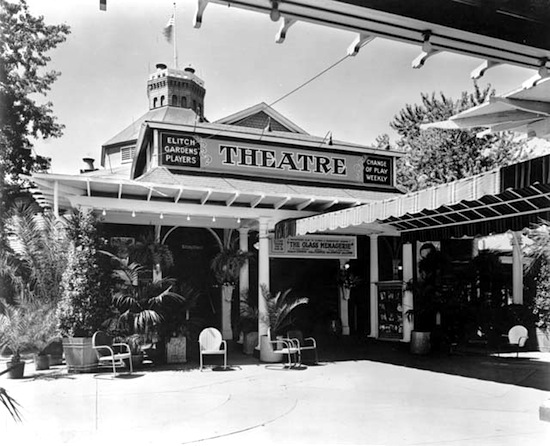
Over the years, many amusement rides and The Trocadero Ballroom were added, and the motto "Not To See Elitch's Is Not To See Denver" was earned. However, its 28-acre location in Denver limited its ability to grow and develop, and it was decided to build a new Elitch Gardens on a 70-acre site in downtown Denver, on a former railroad yard and Superfund cleanup site. Twenty rides from the original Elitch's were transferred to the new site, and the new Elitch Gardens Theme Park opened in 1995. In 1997, Island Kingdom Water Park was added, with a one-price admission to both parks. The old Elitch's site was redeveloped, and the only structures to remain are the carousel building (minus the carousel and now used as a picnic shelter) and the old Elitch Theatre, which is undergoing restoration.
Through most of its history Elitch Gardens was owned by local Denver families, first the Elitchs, then in 1916 by John Mulvihill. His son-in-law Arnold Gurtler inherited the park in 1930. Over the years the original park and its replacement, passed through several more generations of the Gurtler family until 1997, when the Gurtler family sold to Premier Parks, which subsequently purchased and renamed itself Six Flags.
The sale to Premier Parks was probably incited by two factors: 1) the move to the new site, and necessity of building a completely new park, cost more than was anticipated and nearly bankrupt the family, and 2) attendance at the new park (about 1 million for each of the first two years) never reached the projected 1.2 million visitors/year.
The park was known as Six Flags Elitch Gardens from 1997 to 2006, when it was purchased by CNL Lifestyles Properties. The Six Flags name was dropped and PARC Management leased and operated the park until 2011, when CNL terminated the lease with PARC and hired Herschend Family Entertainment to operate it. Herschend, which owns and operates such well-respected parks as Dollywood and Silver Dollar City, appears to be making some efforts to win public support for their efforts to improve Elitch's rather tarnished local reputation by eliciting public input about future attractions being considered for the park.
The new Elitch Gardens never was embraced by the locals as much as the old Elitch's was. Many who remember the old site long for the elegant gardens and structures, its historic rides and friendly atmosphere. The new site, while larger than the old one, is hemmed in by the Platte River on one side and by massive parking lots shared by the park, the Pepsi Center (home of the Denver Nuggets and Colorado Avalanche) and Sports Authority Field at Mile High (Denver Broncos). This limits its ability to expand and add large new attractions without removing current rides and/or structures, and actually the park today has fewer attractions than it did when it opened.
This series of ownership changes since it reopened on its current site has left Elitch Gardens with a mish-mash of styles and a confusing layout. It calls itself a theme park, but there is really no definite stylistic theme. Upon entering the site, guests can head to the right to Island Kingdom, a twenty-acre water park popular on hot Denver days but unoriginal in theming. It has the usual thatch-roofed, sea-side decoration so commonplace in too many water parks. Guests heading to the left enter the only truly themed area of the park, a Main Street, U.S.A.-type block of beautifully designed storefronts and shops, featuring the Trocadero Theater, an homage to the old Elitch Theatre and Trocadero Ballroom from the old Elitch Gardens (with little or no resemblance to either). The far end of the street is dominated by the Big Wheel, a beautiful Ferris wheel surrounded by floral gardens.
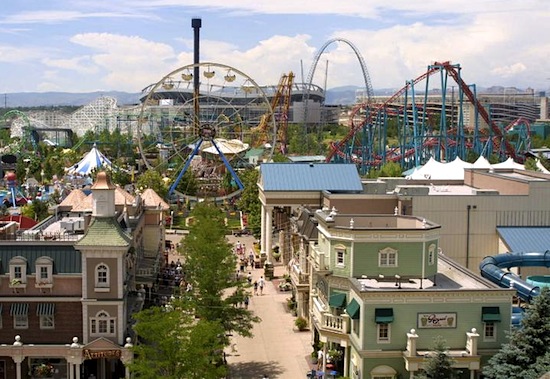
Proceeding around the Big Wheel guests come across a series of confusing paths and dead ends. An attractive Kiddieland (yes, that is what it is called, because the one at the old Elitch's was the first in the country with that name) has all the usual rides expected along with its own theater and a large ball pit/play area. The rest of the park is designed in a rather non-descript Western theme, with some wooded areas, some gardens, and a variety of old carnival spinner rides brought over from the old Elitch's interspersed with newer attractions added when Six Flags owned it. Two water rides, Shipwreck Falls (a shoot-the-chute) and Disaster Canyon (a whitewater rafting ride) occupy a nicely landscaped area spoiled by the fact that the water in the rides was literally brown and muddy. Shipwreck Falls was not running on our visit in July, making me wonder if it the channel had finally silted up. That is not a joke.
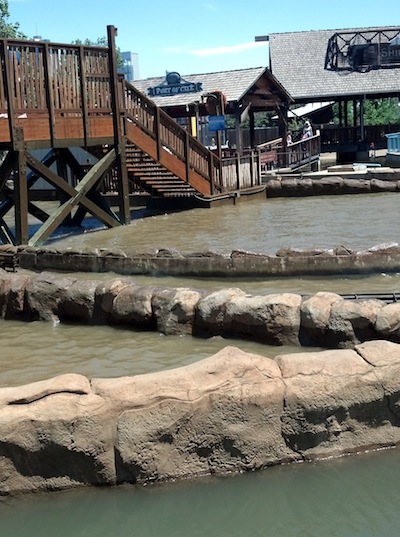
Five adult coasters provide most of the thrills in Elitch Gardens. None are especially unique: Half-Pipe (which was never working on my three visits to Elitch's, and is apparently only opened on weekends — on weekdays, it has a maintenance sign hung on it with no maintenance workers to be seen); Mind Eraser (a steel inverted Vekoma); an originally-named Vekoma boomerang coaster called "Boomerang"; and Sidewinder, a shuttle loop coaster brought from the old Elitch's. The only wooden coaster is Twister II, named for and inspired by the original 1964 Mister Twister at old Elitch Gardens but not relocated. Of all the thrill rides at Elitch Gardens, this coaster probably scared me the most — not because of its design, which is really a fun wooden coaster design, but because of the physical condition of the ride. The wooden steps leading up to the station were rotten and actually bent under a person's weight, and part of them were breaking off (on a subsequent visit some — but not all — of the steps had been replaced).
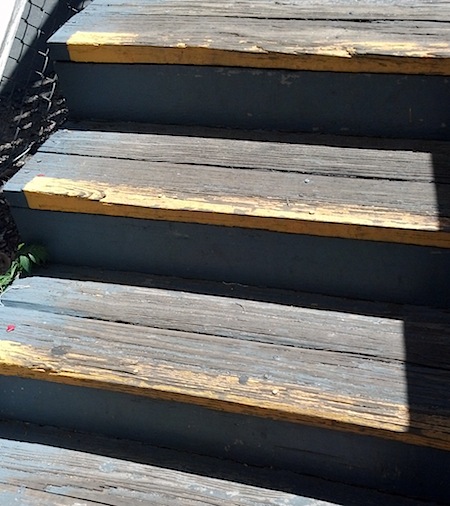
One part of the coaster track goes through a wooden tunnel, and boards were falling off of the side. Handrails had either been painted with the wrong type of paint or the metal had not been properly primed, because the paint was peeling off the surface, leaving multiple colors of undercoats visible down to the bare metal, and flecks of peeled paint laying on the ground underneath the rails. We noticed this paint situation on every other coaster we rode.
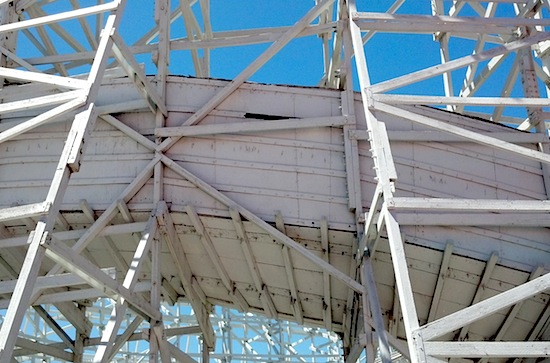
These coasters were also, in my opinion, understaffed. There was nobody at the entrance to the (mostly empty) queues to check riders for height restrictions or to keep them from bringing unapproved items onto the loading platform. One patron tried to bring his half-finished beer onto a coaster, and when the ride operator finally noticed it and did tell him that he could not do so, the ride operator let him set the beer in the bin to be picked up after he rode! Another operator (on Sidewinder) appeared to be doing paperwork, and even though he was supposed to be monitoring the ride controls I never saw him look up from his paperwork.
If there was a bright spot in the park, it was Ghost Blasters, a family-friendly interactive ride through a haunted mansion where guests using "Boo Blasters" shoot at ghosts and haunted objects and battle for the high score in their vehicle. I won every time, beating Marine-trained Jeff Elliott and my own son Anton. Maybe that was why it was a bright spot?
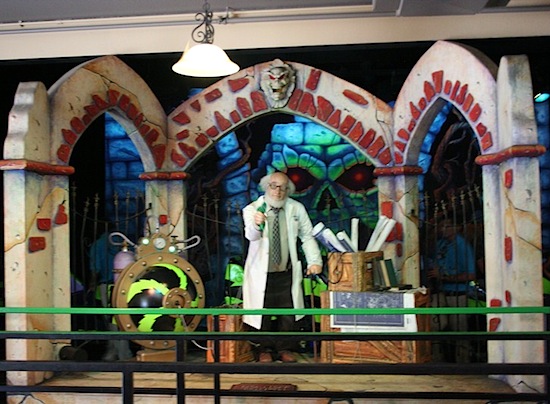
Herschend has had three years to make a positive influence on Elitch Gardens, and many of the problems I witnessed are problems that can be easily addressed with a minimum of cost. First is customer service. Some employees were friendly and helpful — most seemed oblivious to the presence of visitors, chatting amongst themselves about private matters while giving just a cursory check of the seatbelts on the coasters. (And this was just days after the Texas Giant accident!) After ordering a hot dog and fries meal ($6.99) at J.M Mulvihills Bar and Grill, a counter service restaurant, I asked for a glass of ice water and was told that they were not allowed to give me water, that I would have to pay for a bottle of it. I later mentioned that to Jeff and he went on a mission to find complimentary ice water. We went through their indoor food court (more on that later) and asked every booth for water. We were refused every time. We then went to an information booth and asked where we could get a glass of water, and were told to go to very restaurant we started at! I told them that we had been refused. Fortunately, the front gate manager was there, and he took us to the restaurant himself and asked for a glass of ice water for us...and was refused. After a whispered argument the girl behind the counter grudgingly gave Jeff a glass of ice water. Jeff, being the trouble maker he is, handed it to me and asked for one for himself...if looks could kill, Jeff would be dead.
The indoor food court, Rustlers Food Court, was just-plain disgusting. Filthy tables covered with trash and spilled drinks, trash cans overflowing, and this was later in the afternoon, well after the lunch rush was gone and just before the dinner rush would start. We witnessed one guest who had purchased a wrap sandwich which was to come with ranch dressing for a dip. She was informed that they were out of it, and she would have to go find some herself — even though the different booths in the food court had interconnecting doors that the Elitch Garden employee could have used to find it for her.
The third restaurant we visited, Blue Moon Beer Garden, I believe was an attempt to be a sports bar, and had twelve beers on tap. It was a long, curved room with the serving area in the middle and soft drink dispensers at each end. Unfortunately, they only had condiments at one end, the opposite end from where we sat, and the floor around our booth was so wet that I took a foldable "wet floor" sign I saw leaning against the wall and put it in front of our booth. The hot dog sliders we had (choice of Jalapeno, bratwurst or Italian sausage with fries for $9.99) were average in taste but had way too much bread in the buns. The fries were very good, surprisingly — crisp, well seasoned and hot.
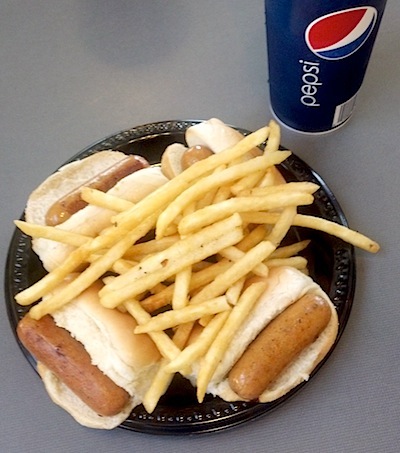
I also saw a vending stand selling pizza for — ready for this — $33/pizza, or $5.75/slice. We didn't try the pizza.
I came to Elitch Gardens wanting to really like it. I had never been to it, and although I had been warned that it was no comparison to the parks that I am most familiar with I still tried to come in with an open mind. I found a park poorly designed, lacking innovation, understaffed, with a policy of refusing to give guests complimentary water even on the hottest days. Denver deserves a better park than this. The future will determine if the new Herschend management team can return Elitch Gardens to the high esteem it once was held in by Denver.
Lakeside Amusement Park: No school like the old school
Lakeside Amusement Park is the other "traditional" amusement park in Denver. Opened in 1908 as The White City (a popular name for parks of that era), it is one of the oldest parks in the country still at its original location. It is a family-oriented park and should be considered a Mecca for any amusement park historians. While much of its original Exposition and White City design survives, the 1930's saw the addition of Art Deco structures and ornamentation to Lakeside. This amalgamation of styles, once common place in amusement parks of the mid-1900's, has all but disappeared from American parks- but not at Lakeside. Here it still exists, and makes a visit to Lakeside like a trip back in time.
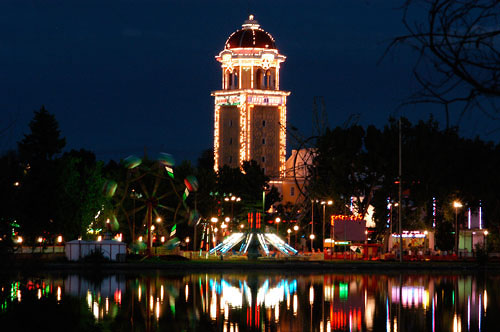
The park is dominated by a historic tower, the 150-foot-tall Tower of Jewels. Constructed in 1907, this beautiful example of Exposition architecture is covered with an estimated 5,000 lights, and is part of the original entrance complex that also housed the Casino Theater and Riviera Ballroom, all still standing but no longer used for their original purposes. Many other original structures from the earliest days of Lakeside still stand, from shelters to ticket booths, giving this park a feeling of authenticity that cannot be duplicated. At night, Lakeside glows with the lights on the Tower of Jewels and with a vast display of neon lights ornamenting the many Art Deco structures throughout the park. During the day, Lakeside is a very pretty park- at night it is a trip back in time to an era when Disneyland didn't exist and every town had its own Lakeside Amusement Park.
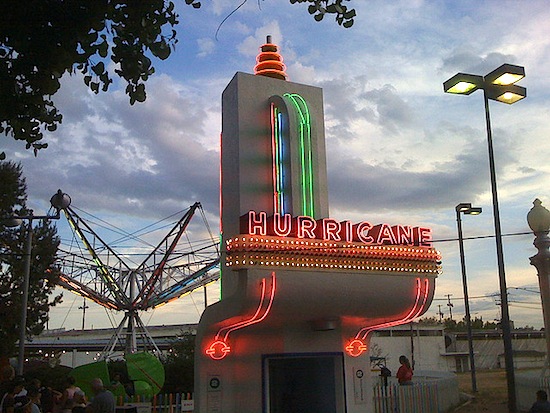
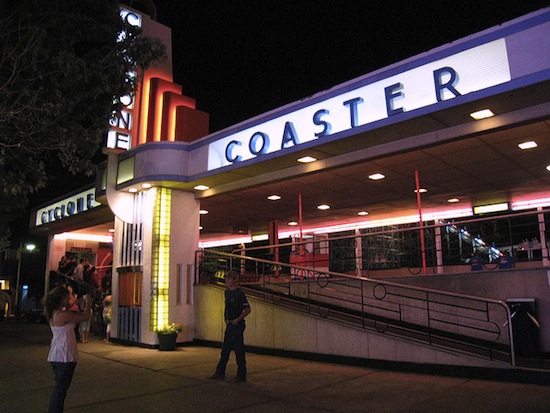
Not only is the design and decoration of Lakeside a throw-back to the past, so is the ticketing. Parking is free, and admission is a whopping $2.50 per person, with a fifty cent rebate coupon good towards the purchase of ride tickets. Rides can be enjoyed by purchasing individual tickets at fifty-cents per ticket. A small kiddie ride might cost only one ticket, while the major attractions such as the roller coasters cost $3, or six tickets. All day passes are also available, costing $14 Monday through Friday and $22 Saturdays, Sundays and holidays.
You will not find many hair-raising thrill rides at Lakeside, no cutting-edge technology or detailed theming. Lakeside is primarily traditional amusement park midway rides, such as the Tilt-A-Whirl, Scrambler, Ferris Wheel, bumper cars and bumper boats, and many rides specific for young children. Three attractions could be considered moderate thrill rides: Zoom, a 150 foot high drop tower; the Cyclone Roller Coaster, a wooden ACE Coaster Classic built in 1940; and the ride which, in my opinion, has the best name of any amusement park ride anywhere, The Wild Chipmunk, a 1955 wild mouse coaster. Standing in the center of the park is the skeletal remains of the Staride, a Ferris wheel-type ride that, even in its rusty condition, looks more like a sculpture rather than an eyesore. The Cyclone has a feature that I have never seen in a wooden coaster- an actual Tunnel of Love. After leaving the beautiful Art Deco loading station and before starting up the first lift hill, the track enters a winding, pitch black tunnel, giving a few moments of privacy that I suspect many thousands of couples over the years have enjoyed. One more historic feature of Lakeside is its 22" gauge miniature railway that circles Lake Rhoda, which gives Lakeside its name. The two steam locomotives, "Puffing Billy" and "Whistling Tom", came from the 1904 Louisiana Purchase Exposition in St. Louis; the third locomotive, modeled after the famous California Zephyr, is the world's first miniature diesel locomotive.
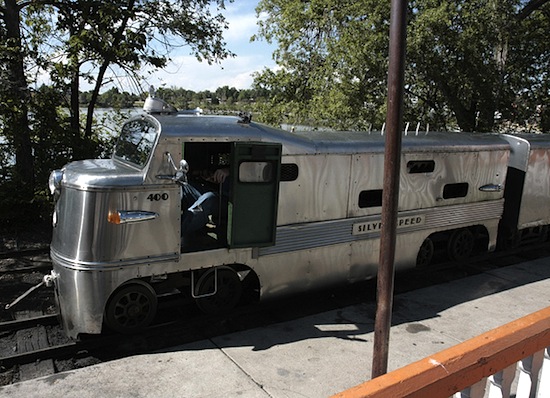
Lakeside is certainly not the perfect amusement park. Along with the historic aspect of it comes the fact that most of it is old. Much of it appears to be a bit run-down and needs a bit of paint. Many of the lights on the Tower of Jewels were burned out. Locals consider it (using a phrase I heard from one of the locals) the "ghetto park," although everyone who has gone there seems to enjoy it if they know what to expect, an old park in need of some cosmetic touching-up. It is a park of old, traditional rides, lots of rides for young children, a few medium-thrill rides, a very good woodie and a coaster that puts the "wild" in "wild mouse" (the Wild Chipmunk — I do love that name!). It is what it is, and doesn't try to be anything other than that. It is an old, traditional amusement park such as used to be found in every town across the country.
And thank God it still is here to enjoy and experience.
Is Lakeside Amusement Park a "destination park" worth a special trip to Denver to visit? No, but if you are a history buff, especially one interested in amusement park history and architecture and you find yourself in the Denver area, a visit to Lakeside is a visit to be enjoyed and treasured, a trip back to a simpler age and time.
And you can't beat the price!
Heritage Square: Almost Denver's Disneyland
Heritage Square Family Entertainment Village in Golden, Colorado began in 1957 as Magic Mountain, and was one of, if not the first theme park to be created after the Disneyland concept. A group of local businessmen hired Marco Engineering, Inc. (led by the former Disneyland V.P. C.V. Wood, Jr.) to create a new park with what is called a Storybook Victorian theme. Designed by several Hollywood art directors, including Disney veteran Dick Kelsey (art director for "Bambi", "Dumbo" and portions of "Fantasia" and "Pinocchio"), Heritage Square remains one of the best surviving examples of this design style, which incorporates stage and film design concepts, forced perspective and unusual architectural details to make an artificially-designed setting look and feel both real and welcoming.
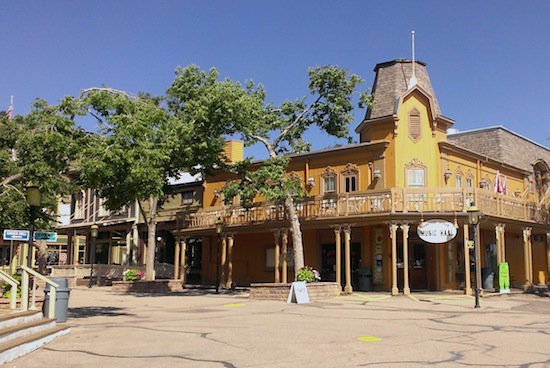
The original Magic Mountain was to be a much larger park than the present Heritage Square, with six themed lands based on Colorado history, culture and future development. A ski resort, which was completed, was one of the first ski runs in North America to rely on artificial snow. The ski resort was successful, but the theme park wasn't. Financial troubles caused the construction of several of the themed lands to be scrapped, and the park closed in 1960. Attempts to save it by outside investors failed, and its amusement rides were sold to a new park, Six Flags Over Texas, being built in Arlington, Texas. The remaining buildings from the completed lands (Cavalry Post and Stockade, Centennial City (an old west downtown area) and part of Fairgrounds) stood idle.
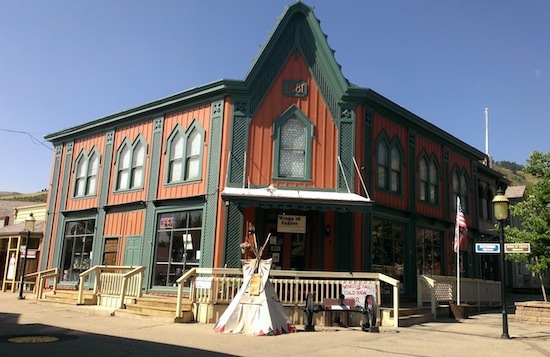
1970 saw the purchase of the site by the Woodmore Corporation, which reopened the park in 1971 as Heritage Square Family Entertainment Village, a themed shopping village featuring local craftsmen and artisans, a comedy melodrama theatre, and a beer garden. Over the years ownership has changed many times. It is currently owned by Lafarge, which also owns the large quarry next door and uses Heritage Square as a sound buffer between the quarry's blasting and the city of Golden.
Heritage Square is a very unusual park in that each attraction is independently owned and operated. There is no charge for parking or admission to the grounds, but each attraction requires individual ticket purchases, and what appears to be one amusement park is actually two independent parks sitting side-by-side with different ticket booths. The Heritage Square Amusement Park has the more traditional flat spinner carnival-type rides, while Miner's Maze Adventureland has slightly more physical attractions such as a spring bungee jump, climbing wall and, of course, the Miner's Maze.
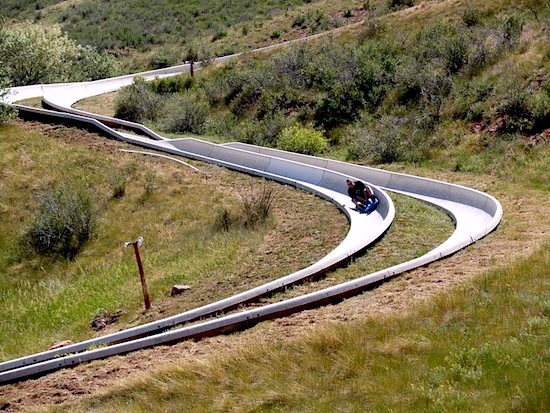
The most popular attraction at Heritage Square is the Alpine Slide, a winding slightly-banked trough snaking down the side of Jackson Hill where riders on wheeled sleds speed down the hillside held in by nothing but gravity. Riders ascend the hill (a mountain to this Ohio flatlander) where they are provided a personal sled to ride down the hill. Each sled has a brake to give the rider some control, and there are two different parallel troughs, one slow (for beginners) and one fast (for experienced riders). Prices start at $8/ride for 7 years and older, up to $38 for five rides. Children 6 and under cost $5 and must ride with a paying 18-year-old driver. It really is a great ride, thrilling and much less intimidating the second time down.
The rest of Heritage Square is occupied by go-carts, a small lake with Swan paddle boats, a miniature golf course, the shopping streets with several privately-operated shops selling such things as Native American goods, toys and souvenirs, a large Victorian-themed music hall, restaurants (one of which, Notz Landing, was featured on the Food Network show "Unwrapped") and even a large church complex, the Red Rocks Church. The park is encircled by the Rio Golden Railroad, a narrow-gauge train which crosses over the entrance of the park, reminiscent of Disneyland.
Heritage Square Family Entertainment Park is just that — a family park aimed at the local Denver and central Colorado population. It is absolutely NOT a destination park, but for a theme park fan with a special interest in the history of theme parks, and especially in the effect that Disneyland's design had on the development of other parks, and if you are in the Denver/Golden, Colorado area and have a few hours to kill, Heritage Square is a fun and interesting diversion, especially for families with small children and tweens, teens and adults with no fear of racing down a hillside on a wheeled sled with no seat belt, no attached track and no fear. With the exception of the Alpine sled, though, there is really very little for thrill-seeking adults or even teens/tweens to do unless they are there to keep the younger children entertained. It is not a full-day park, but fortunately it is just a short drive to the Coors Brewery (now officially the Golden Brewery since Coors and Miller merged), which offers free tours of its fascinating facility (and free beer and soft drink samples at the end of the tour). Combining half a day at Heritage Square and half a day at the brewery would be the perfect way to satisfy the entire family.
Tweet
This article has been archived and is no longer accepting comments.
Regarding the tunnel on Mr. Twister, I guess that was fairly common for rides of a certain era. Knoebels' Phoenix has a lengthy tunnel to start, although I don't know if that was featured in its original location. And less than two weeks ago, I made my first visit to PA's Conneaut Lake Park, where the 1938 Blue Streak coaster features a verrrry long tunnel before the lift hill.